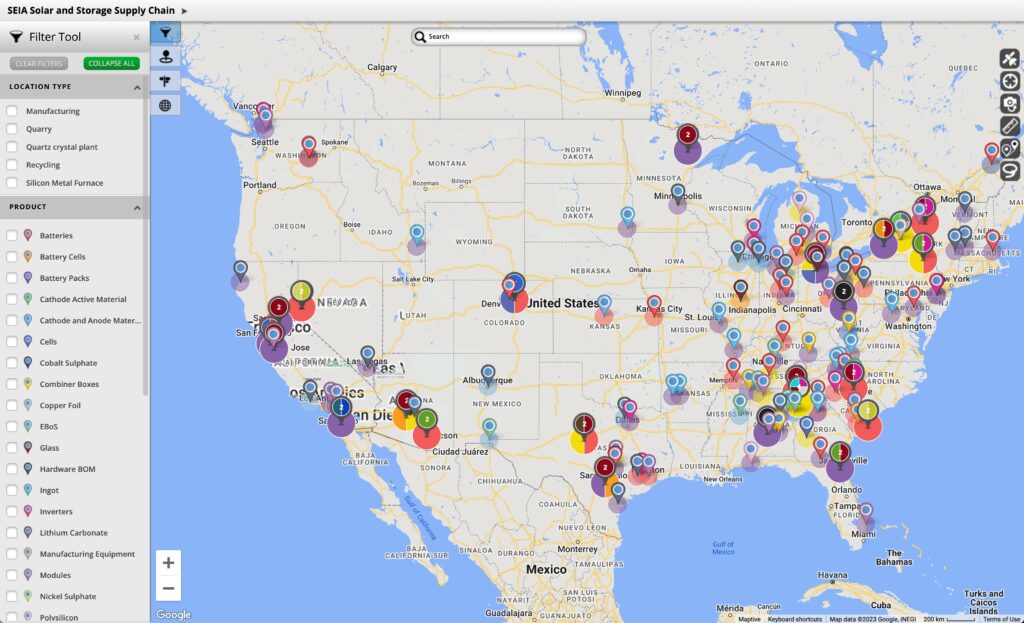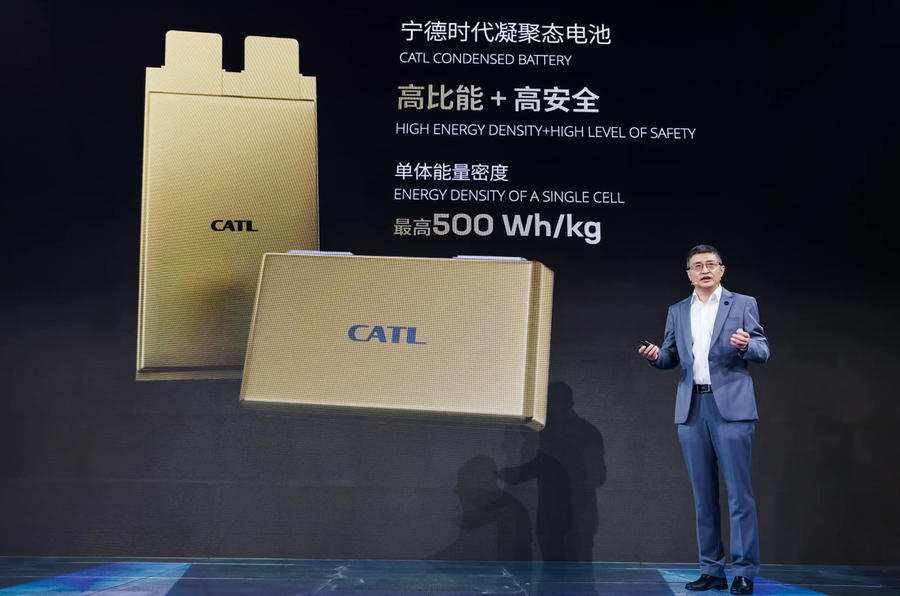It’s hard to believe 2023 is half over. It’s been a whirlwind year, dominated by clean energy policy debates, record-breaking inflation, and mass announcements of bringing solar manufacturing onshore. In other words: a mixed bag for solar, which is nothing new! Review some of the recent industry developments below, and remember our Kinect Solar experts are your resource to navigate it all.
Post-IRA manufacturing growth is still surging
We’re still seeing regular announcements of new solar and energy storage manufacturing facilities in the US. The American Clean Power Association says since the Inflation Reduction Act was passed in August, there’s been $150 billion in funding announced for the clean-energy utility sector, 46 new manufacturing facilities, nearly 20,000 new jobs, and 96GW of announced utility-scale projects: more than the previous five years combined.

US Supply Chain Interactive Map
Keep tabs on all of the new additions to the US solar supply chain with this incredible dashboard from SEIA. Filter by product type, facility status, and more.
The debt ceiling bill included permitting reform measures
Post-IRA, there’s a huge appetite for clean energy projects, but interconnection backlogs continue to stall progress. More than 2TW of electricity generation and storage (a majority of which is solar) are stuck in interconnection queues. This backlog is costing developers significant time and money. It’s going to take committed collaboration from solar developers, transmission owners, and the government to make the process functional.
Anyone who’s worked in solar for any length of time knows the permitting and interconnection process is a nightmare – it’s a major obstacle to electrification. The IRA was a good first step at permitting reform, and it appears permitting measures included in the debt ceiling bill are also a good step (ANY step is welcome). However, many more steps are needed. Though both sides of the political aisle see reform as necessary, views about how interconnection should happen are divided.
Both sides have promised to seek additional permitting reforms, but there is some concern that now the urgency of defaulting on the national debt has passed, the motivation for more across-the-aisle collaboration has too. We hope not. One advantage of a lack of clearer direction is that it may allow FERC to step in. It sounds like they have plans to do so on the interconnection side, which is badly needed and would be most welcome.
A big downside of the debt-ceiling deal is that fossil fuel projects will be lumped in with renewable energy projects, so we’ll be seeing more natural gas power plants along with solar farms and windmills. The deadlines for environmental reviews may result in further environmental harm, especially in the case of fossil fuel projects.
In any case, action taken by FERC to speed up the interconnection process is only half the battle. There’s still the permitting process, which in many ways is controlled by politicians. Moreover, these actions were needed 5-10 years ago, before we were neck deep in climate change-related events. In that light, the NERC’s 18 month study timeline is a painful delay (and we hope the FERC’s chairman is true to his word that their organization will take action in tandem with the 18-month study).
As we tend to be of the mind that any step in the right direction is a good thing, we’re happy to see some measures formalized last quarter and we hope to see many more steps follow.
Clean energy policy continues to be hotly debated
Even before the debt ceiling package negotiations, the current Congress has been focused, for better or worse, on solar debates and bills that could affect the future of clean energy in the US. Solar professionals breathed a sigh of relief after President Biden issued a two-year moratorium on tariffs related to the AD/CVD investigation but lawmakers in both houses voted to overturn the moratorium. The Biden administration then vetoed the resolution, in what we hope is the final act in this ongoing drama, as it is unlikely the bill could get approval from a two-thirds majority, which would be required to overturn the veto. The president said he does not plan to extend the moratorium past its 2024 expiration date.

Biden Veto of H.J. Res. 39
US President Joe Biden vetoed a US Congressional Resolution that would have abolished the trade remedy duty exemption for imported solar cell products from Vietnam, Thailand, Cambodia, Malaysia.
The tariffs aren’t the only solar political football of the hour. As the debt ceiling debate persisted, there was a push to de-fund provisions in the IRA, however the final bill left the IRA’s tax credits unchanged.
In other policy news, the IRS issued long-awaited guidance for Domestic Content Requirements under the IRA. The proposed guidelines are a first step and additional information is expected in August. Initial guidance for Elective Pay and Transferability provisions was also issued, which would allow tax-exempt and government entities to receive up to 12 payments for renewables projects under the ITC or PTC. This will give state and local governments, as well as large nonprofits, better access to renewable energy deployment.
Summer heatwaves are bringing grid challenges
Entering the hot part of the year for the northern hemisphere is again highlighting the current limitations of the US electrical grid. The NERC estimates two-thirds of North America is at risk for energy shortfalls in the hot temperatures. In Texas, electrical capacity from new solar projects has been instrumental in keeping the grid working as intended and air conditioners running. We can’t overstate how important it is to include clean energy and storage in conversations about grid stability.
California’s NEM 3.0 rolls out
The much-discussed NEM 3.0 went into effect April 15 and homeowners who deploy solar in California after that date will earn a drastically reduced rate on electricity they export to the grid (about 75 percent less). This will shift the typical payback period on new solar from 5-6 years to 9-10 years. Analyses indicate a slow-down in the California solar market over the next several months, with expected recovery beginning in 2025. Third-party providers (TPOs) and energy storage deployment are both expected to grow rapidly in the NEM 3.0 landscape. Solar companies have launched consumer storage initiatives to offset the loss of net metering incentives and the adoption of PPAs and solar leases is expected to increase under the new structure.
Historic time for electric vehicles and battery technology, despite infrastructure concerns
We’re in the midst of an electric vehicle (EV) revolution. Climate advocates hope to follow in the footsteps of Norway, which saw its EV purchasing rate jump from less than 3 percent to over 79 percent in the past decade. The US electrical infrastructure, however, has come into sharp focus as the biggest potential barrier to electrification, which is vital for EV success.
There is a chance EVs could serve a dual purpose by helping address grid shortages. “The EVs themselves can be part of the solution,” says the director of the climate program at the University of California at Berkeley’s Center for Law, Energy and the Environment. Bidirectional charging is already commercially available in the US on some makes and models (like the Ford F-150 Lightning and the Hyundai Ioniq 5), with many more on the way in 2024.
The possibilities for EV battery capabilities are sky-high: energy storage giant CATL announced a condensed battery with an energy density of up to 500Wh/kg, which would allow electrical powering of the kinds of things we’ve only dreamed of until now (from motorcycles to semi-trucks to airplanes), and dramatically extend the range of passenger EVs.

CATL Announces Condensed Battery
CATL, the largest battery manufacturer in the world, announced the launch of a condensed battery with an energy density of up to 500Wh/kg. If that proves to be true, this will be a huge leap forward in battery technology.
Ongoing upheaval for logistics
The natural rhythm of the logistics industry plays a big part in the ups and downs of the “solar coaster.” Recently, ocean shipping rates have plummeted and ground parcel delivery rates have reached record highs. Depending on the business model, this volatility may be helping or straining bottom lines for solar business owners. Trucking rates have fallen as well, but expected layoffs in the industry are likely to drive rates up again if supply shrinks below demand levels.
Some good news just in time for the peak summer shipping season, a tentative deal between West Coast port workers and the Pacific Maritime Association has been reached after months of drawn-out negotiations and port labor activities are beginning to return to normal. Labor disputes at west-coast ports had been ongoing, and labor shortages at several California ports resulted in limited operations for a time.
Q2 2023 wrapped
After a rocky start to the calendar year, we’re glad to see hotly debated clean energy policies settled for now, and a strong surge of clean energy projects and manufacturing announcements continuing. We’re keeping a close eye on where things will land in the logistics realm, as post-pandemic supply and demand remains unbalanced and labor challenges continue. We’re also hopeful for additional innovative and cooperative answers to transmission and interconnection problems.
We’re big believers in the ingenuity and tenacity of solar professionals, and we can’t wait to see what you build next. Remember Kinect Solar is always on your side – turn to our solar pros for great savings on solar equipment, help with procurement, and streamlined logistics.
Sources and further reading
How the debt ceiling bill’s permitting deal hurt the outlook for deeper reforms, transmission legislation [Utility Dive]
IRS Guidelines Issued for Domestic Content Requirements [Kinect Solar]
Senate and House both vote to overturn presidential pause on solar tariffs [Solar Power World]
Clean Energy Is Under Attack in Our Nation’s Capital [SEIA]
Since IRA, $150 billion investment, 46 factories, 18,000 jobs in renewable energy [PV Magazine]
US Treasury releases IRA guidance to widen net of tax credit recipients [PV Tech]
Two-thirds of North America is at risk of energy shortfalls in high summer heat, NERC says [EIA]
Solar Power Bails Out Texas Grid during Major Heat Wave [Scientific American]
NEM 3.0: what does it mean for you? [Energy Sage]
A new era for U.S. residential solar finance: ITC, loan market headwinds shaking up landscape [Solar Builder]
Biden’s ambitious climate plan for EVs faces these big hurdles [Washington Post]
Ground parcel delivery costs reach record high as rate hikes take hold [Supply Chain Dive]
A labor flareup is affecting operations at several West Coast ports [Supply Chain Dive]
PMA, ILWU reach tentative deal on 6-year contract [Supply Chain Dive]
Grid connections will remain a huge challenge for clean energy if FERC fails to meet this moment [Utility Dive]
As California grid interconnection requests triple, analysts assess CAISO’s moves to handle the influx [Utility Dive]
This post is provided for general informational purposes only and does not constitute legal or financial advice. Kinect Solar makes no representation or warranty of any kind, express or implied, regarding the accuracy, adequacy, validity, reliability, availability, or completeness of this information. Kinect Solar is not liable or responsible for any damages or losses resulting from or related to your use of this information. This post includes links to websites not affiliated with or endorsed by Kinect Solar.